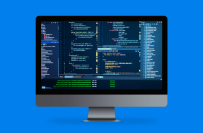Chatea con Ava - Tu consultor de negocios IA
¡Hola, soy Ava, tu guía de IA para potenciar tu negocio!
Ya sea que dirijas una empresa o sueñes con iniciar una, estoy aquí para hacer realidad tu visión gracias a los freelancers que usan IA. Comparte los objetivos de tu negocio y juntos crearemos un proyecto en los que nuestros talentosos freelancers puedan ofertar. ¡Hagamos realidad tu visión!
Tengo un negocio
Estoy comenzando un negocio
Algo salió mal al enviar la conversación a tu correo electrónico. Por favor, intenta de nuevo más tarde.
Solo puedes guardar tu conversación una vez por hora. Por favor, intenta de nuevo más tarde.
Tu conversación es demasiado corta. Sigue chateando con Ava para poder guardar.
Top tools for mobile app development
If you're building an app from the ground up, you must only use high quality resources. Here's a rundown of some of the best tools for the job.
26 abr 2019 • Lectura de 9 minutos
Actualizado el 15 ene 2020 por Adam S.

Content Manager at Freelancer.com
Falló el copiado al portapapeles. Intenta de nuevo después de ajustar tus permisos.
Copiado al portapapeles.

If you're building an app from the ground up, you're going to need some help. Here's a rundown of the best tools for the job.
Mobile app development is a complex process, from coding to designing user interfaces to integrating advanced functions like augmented reality to getting your app in front of users. There's no single magic tool that can take your app from concept to deployment, but using the tools below together can bring your idea to reality.
Need Help Building Your App?
Best framework tools for mobile app development
Flutter is a game-changer for mobile app development. The Google-designed framework allows developers to write apps for any platform in the same codebase.
It works for iOS, Android or web apps, and relies on the Dart programming language. Dart is a simplified, easy-to-learn language that's incredibly versatile.
In addition to working cross-platform, Flutter also works with tools like Square to support in-app payments, Flare to seamlessly integrate animations and Codemagic to help build and package apps. What's more, Hummingbird, Flutter's tool for web development, can build true Progressive Web Apps, which are set to be a major mobile app development trend in 2019.
PhoneGap is Adobe's commercial version of open source tool Apache Cordova. PhoneGap relieves the need for developers to verse themselves in mobile programming languages, instead relying on web-based languages like HTML, CSS and JavaScript. It's used to build hybrid apps.
PhoneGap is well suited to developing cross-platform apps, as it can use a single codebase for iOS, Android, BlackBerry, Ubuntu, Mac OS and a variety of other operating systems. It also offers access to an expansive library of plug-ins that allow apps to use native device features such as accessing the device's camera.
PhoneGap is free, but is more effective when linked up with a PhoneGap Build account for $9.99 USD/month and a Creative Cloud account at $52.99 USD/month, which will give you access to Adobe's other app development tools such as Adobe XD.
Corona accelerates the app creation process with Lua, a simple scripting language suited to coding novices. It allows you to use a single codebase to publish cross-platform and supports Android, iOS, Amazon Fire, Mac and Windows desktop, and even smart TV platforms like Apple TV and Android TV.
The Corona Simulator gives you a real-time look at any code changes, while the Live Build feature pushes instant updates to any device on your network. Corona also allows you to integrate your Lua code with an XCode or Android Studio project to deliver any functionality not available through its extensive plug-in library.
Featured Work in Mobile App Development
Xamarin is a Microsoft tool that allows you to build apps that appear native across different platforms. With Xamarin, you can create a UI-specific code layer that will make your app look entirely native on each platform. Xamarin also integrates with operating systems for wearables such as Apple Watch or Android Wear.
Xamarin uses C#, and also allows you to pull in platform-specific codebase, such as Swift for iOS.
The Xamarin Studio Community Edition is free, and Xamarin is also included in Microsoft Visual Studio, which is $45 USD/month for the Professional Edition and $250 USD/month for the Enterprise Edition.
The power of jQuery Mobile is in integrating jQuery and jQuery UI with CSS3 and HTML5 into a single framework. If you're already familiar with jQuery, you'll feel right at home in jQuery Mobile.
The framework lets you develop in mobile and desktop, and works across iOS, Android, BlackBerry and a host of other mobile operating systems. It integrates mouse events into touch events, allowing you to build true progressive web apps. The jQuery Themeroller also lets you customize and standardize the look and feel of your app across platforms.
Featured Work in Mobile App Development
Best AR and VR tools for mobile app development
1. Google ARCore
ARCore is Google's tool for augmented reality (AR) app development. ARCore uses various APIs to help the user's device track its motion and position, understand and detect its environment and estimate the environment's lighting conditions.
The tool's lighting detection means your virtual object can be lit under the same conditions as its environment, and its ability to detect vertical and horizontal feature points allows you to place virtual objects on flat planes. ARCore is platform-specific to Android, meaning you'll have some work ahead of you to make your AR experience work cross-platform.
2. Apple ARKit 2
ARKit 2 lets you provide AR experiences that allow multiple users to participate simultaneously. It also allows users to stop the app and resume it later in the same state.
In addition to 3D object recognition, ARKit also supports 2D object recognition for items like posters or signs. The limitation of ARKit, like ARCore, is that it's platform specific, working off Apple's native XCode codebase.
3. Wikitude
Wikitude works cross-platform to create AR experiences for Android, iOS or Windows. You can use Native or JavaScript, or Unity, Cordova or Xamarin to create a seamless AR experience for phones, tablets and smart glasses on all three supported operating systems.
Wikitude can augment multiple images simultaneously and can also recognize, track and augment 2D images.
4. Vuforia
Vuforia is primarily for enterprise applications in industries like aerospace, electronics, healthcare and automotive manufacturing. It touts itself as providing enterprise solutions to manufacture, train and service more efficiently.
Vuforia Studio allows developers to integrate existing 3D CAD and animated sequences into AR apps. Vuforia Engine allows for cross-platform development of AR apps. The tools let developers build AR apps for mobile and digital eyewear devices, including the Microsoft HoloLens.
5. ARToolKit
ARToolKit is an open-source C and C++ library of AR software that works cross-platform. It provides a simple framework for creating AR apps by algorithmically tracking to calculate the device's camera position relative to physical markers. This allows for fast, real-time AR applications.
ARToolKit is distributed for MacOS, Windows, Linux and SGI IRIX.
Best animation tools for mobile app development
1. Flare
Flare integrates with Flutter to create animations for your apps. You can draw and animate directly in Flare, or you can import pre-existing vector art in SVG or PSD.
Flare also provides some easy animation tools like skeletal animations, which allow you to add a structure of moving joints to vector and raster images. You can also create interactive buttons and icons that run in real time. Best of all, it easily integrates into Flutter.
2. Adobe After Effects
Adobe After Effects works best in conjunction with other Creative Suite products. You'll create a vector image in Illustrator and animate in After Effects. An After Effects plugin called Bodymovin can export your animation file as JavaScript for easy integration into your codebase.
While After Effects doesn't offer the all-in-one integration of some other animation tools, its versatility makes it worthy of consideration.
3. Kite Compositor
Kite Compositor is an animation and prototyping tool for Mac and iOS. It uses a simple drag and drop interface and generates native Swift or Objective-C code. It can also build animations for different interfaces, such as the Apple Watch. Plus you can import designs from Sketch or Adobe XD.
4. Origami
Origami Studio is a prototyping tool built and used by designers at Facebook. It allows you to import design assets from Sketch. You can then assign actions to layers for user actions, such as a tap on the device's screen. Origami allows you to easily add transitions between pages and actions on your app.
It's important to remember, though, that Origami is a prototyping tool. It's a good tool for designing the look and feel of your app, but you'll still have coding work ahead of you to make it a reality.
Best AI tools for mobile app development
1. ML Kit by Google
ML Kit is a mobile-optimized machine learning development kit. Its base APIs include functions like face detection, optical character recognition, image identification, barcode scanning and landmark detection. Google is also developing a chatbot function for the kit. ML Kit also works cross-platform on iOS and Android devices.
Google is continuing to develop and add new base APIs to the toolkit to cover more use cases. It also supports existing TensorFlow Lite models. It's built to work within Google's Firebase development console.
2. Core ML 2
Core ML 2 is Apple's machine learning app development kit that allows machine learning models to run locally on the user's device, meaning your app can apply machine learning cases regardless of the user's network connection.
Because Core ML runs locally, it relies on pretrained models and decision trees. Unlike ML Kit, it doesn't work cross-platform.
3. Microsoft Cognitive Services
Cognitive Services work with Microsoft Azure to deliver a set of APIs and SDKs to allow developers to build AI into their apps without an extensive knowledge of data science. The APIs on offer fall into five main categories: vision, speech, language, search and knowledge.
The vision APIs analyze images and videos; the speech APIs aid with speech recognition; the language APIs help your app understand the intent behind user language; the knowledge APIs deliver relevant research from scientific journals and the search APIs apply machine learning to Bing searches.
4. Caffe2
Caffe2 is Facebook's contribution to artificial intelligence tools for developers. The platform uses native and interchangeable Python and C++ APIs. It integrates with Visual Studio, Android Studio and Xcode.
The tool leverages community contributions to build new algorithms. It also offers access to a "model zoo" with pre-trained machine learning models.
5. OpenCV
OpenCV, or the Open Source Computer Vision Library, is focused on visual machine learning. It's used for facial recognition, object identification, finding similar images in databases, extracting 3D models of objects in images and a host of other features.
The tool allows you to work in Java, C++ and Python and supports iOS and Android. It also integrates with TensorFlow and PyTorch.
Marketing tools
1. Pushwoosh
Pushwoosh lets you craft, segment and personalize push notifications to keep your users engaged. It also offers in-app messaging services, deep linking and location-based push notifications.
The service gives you access to advanced analytics, lets you create A/B tests to trial new marketing strategies and offers tools to track conversion and discover your audience segments.
2. App Radar
App Radar aims to help you push your app to top store pages using detailed analytics of how users are finding your app and apps like yours. Its "App Store Optimization" gives you keyword rankings and offers optimization suggestions to tailor your app description for maximum visibility. It even tells you the keywords your competitors are using.
The tool also allows you to push updates for multiple apps simultaneously, both in the Apple App Store and Google Play.
3. HARO
HARO, or Help a Reporter Out, is actually aimed at journalists. It connects journalists with sources who can provide commentary on a range of issues. But it's also a tool for people wishing to provide commentary and promote their brands.
You can register on HARO as a source and you'll receive three daily emails with source requests relevant to your industry. If you see one that you can provide commentary on, while also promoting your app, you reply to a masked email address with answers to the journalist's questions and a bio with contact information.
4. Clickky
Clickky monetizes your app by placing relevant, high-performing ads in your content. You choose the ad type and format and then integrate the code into your app. You can also exchange ads with other app developers for free.
Clickky also offers robust analytics tools to show you how much your app is earning in real time.
5. App Annie
App Annie is the gold standard in monitoring information about your mobile app. Think of it as Google Analytics for apps. You can analyze app market trends by downloads and revenue, keep an eye on competitors and evaluate top monetization strategies.
App Annie also lets you search for keywords to optimize your app description, monitor competitors' ad campaigns and view the best ad platforms across different regions.
Get Your App Built Today!
Historias relacionadas
Habla con uno de nuestros Copilotos técnicos para que te ayude con tu proyecto
Artículos recomendados solo para ti

Struggling to come up with the best idea? Our exhaustive guide runs through the idea generation process to help you tap into your inner Steve Jobs.
10 min read

Learn the complete end-to-end process of building a successful website for your business in our comprehensive guide
19 min read

C++ is the best programming language for games because of the large body of knowledge and frameworks built around. Here's why it's special.
10 min read

You can hire a programmer to solve just about any complex problem, the problem is knowing how to hire the right professional for the job. Learn how..
13 min read
¡Gracias! Te hemos enviado un enlace para reclamar tu crédito gratuito.
Algo salió mal al enviar tu correo electrónico. Por favor, intenta de nuevo.
Cargando visualización previa
Permiso concedido para Geolocalización.
Tu sesión de acceso ha expirado y has sido desconectado. Por favor, inica sesión nuevamente.








































